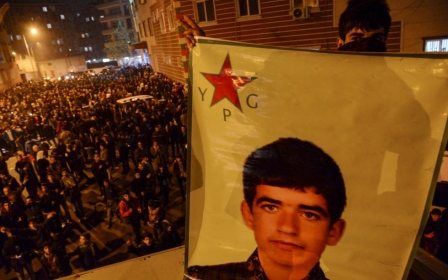Endless enemies - how the US is supporting the Islamic State by fighting it

Geopolitics is a murky game. Precisely how murky is reflected in the well-worn phrase, “The enemy of my enemy is my friend.”
What happens, though, when you follow that ancient proverb with the faith of a religious believer?
Now that the war on the “Islamic State” (IS) is, ostensibly, in full-swing, the US is making “friends” out of enemies, old and new. Among our new friends is al-Qaeda.
Except they are supposedly not “our” friends, but friends of our allies.
Al-Qaeda, freedom fighters for Gulf monarchies
Saudi Arabia, Qatar and Turkey are now working to support al-Qaeda’s official arm in Syria, Jabhat al-Nusra, to re-take Syrian territory from Bashir al-Assad. The strategy resulted in a coalition of rebel groups, led by the al-Qaeda faction, conquering Idlib in April.
The three regional powers claim they are hoping to compel al-Nusra to renounce its relationship to al-Qaeda – but the reality is they are funding the al-Qaeda affiliate without any meaningful guarantee of control.
“Nusra will stay with al-Qaeda unless the other rebel forces are able to unify into one force,” said one al-Nusra member. “[Al-Qaeda leader Ayman] al-Zawahiri says the unification of Muslims is more important than membership in any group.”
According to Rami Abdelrahman of the Syrian Observatory for Human Rights, al-Nusra is “not so different from IS. They want to make an emirate but are looking for the right opportunity.”
Publicly, the official line is that the Saudi-Qatari-Turkish strategy is not directly funding al-Nusra, although the geopolitical coalition is aware that al-Nusra will benefit from the support to Islamist rebel groups.
Privately, a source in the Saudi royal family involved in security policy said that 90 percent of the rebels receiving military and other aid were members of al-Nusra and rival jihadist group Ahrar al-Sham, whose founding member Mohamed Bahaiah is also a senior al-Qaeda operative. As much as 40 percent of the rebels’ requirements are supplied by the Saudis, Turks and Qatar, the remainder being self-financed.
The strategy was, according to journalist Gareth Porter, rubber-stamped at the Camp David summit in May. The Gulf states and Turkey would acquiesce to the US-Iran nuclear deal, as along the US would guarantee containing Iranian influence in the region – part of which would involve turning a blind eye to Saudi, Qatari and Turkish support for al-Nusra and other Sunni jihadist factions.
Al-Qaeda, our new ‘moderate’ rebels
But according to the Washington Post, the “Gulf leaders who are funding the opposition” were urged by the Obama administration to somehow “keep control of their clients, so that a post-Assad regime isn’t controlled by extremists for IS or al-Qaeda”.
Like its allies, publicly Western governments disavow responsibility for the strategy, claiming to be “alarmed” at the initiative as they are firmly opposed to “arming and funding jihadist extremists”. Naïve pundits point to US bombing of al-Nusra positions in Aleppo during the early phase of the campaign against IS.
But privately, several rebel commanders leading the recent Idlib operations told the Brookings Institute’s Charles Lister “that the US-led operations room in southern Turkey, which coordinates the provision of lethal and non-lethal support to vetted opposition groups, was instrumental in facilitating their [Islamists’] involvement in the operation from early April onwards. That operations room – along with another in Jordan, which covers Syria’s south – also appears to have dramatically increased its level of assistance and provision of intelligence to vetted groups in recent weeks”.
In other words, al-Qaeda’s official arm in Syria, and another group closely affiliated with al-Qaeda, were among the “moderate” vetted groups receiving arms and aid from the Gulf states and Turkey, under the supervision of US military intelligence operatives in the field.
“Whereas these multinational operations rooms have previously demanded that recipients of military assistance cease direct coordination with groups like Jabhat al-Nusra,” wrote Lister, “recent dynamics in Idlib appear to have demonstrated something different. Not only were weapons shipments increased to the so-called ‘vetted groups,’ but the operations room specifically encouraged a closer cooperation with Islamists commanding frontline operations.
The most likely explanation for such a move is pressure from the newly emboldened regional alliance comprising Turkey, Saudi Arabia and Qatar. The United States also is looking for ways to prove its continued alignment with its traditional Sunni Gulf allies, amid the broader context of its rapprochement with Iran.”
Al-Qaeda, not-so-new ‘moderate’ rebels
Except: how new, really, is the support for al-Qaeda-affiliated Islamist rebels?
Not very, according to Vice President Joe Biden, who last year conceded that the Gulf states and Turkey “poured hundreds of millions of dollars and tens, thousands of tonnes of weapons into anyone who would fight against Assad – except that the people who were being supplied were al-Nusra and al-Qaeda and the extremist elements of jihadis coming from other parts of the world.”
Biden even admitted that this funding went to al-Qaeda in Iraq, which expanded its operations in Syria under the covert anti-Assad strategy - before metamorphosing into IS: “Where did all of this go? All of a sudden everybody’s awakened because this outfit called ISIL which was ‘al-Qaeda in Iraq,’ which when they were essentially thrown out of Iraq, found open space in territory in eastern Syria, work[ed] with Al Nusra who we declared a terrorist group early on…”
But Biden’s claim that “we could not convince our colleagues to stop supplying them” conceals the fact that the CIA was directly involved in managing these rebel supply networks.
In 2012, as revealed by a declassified raw intelligence report from the Pentagon’s Defence Intelligence Agency (DIA), the US intelligence community was fully aware that IS-precursor “al-Qaeda in Iraq” was at the core of the anti-Assad rebel movement, supported by the “West, Gulf states and Turkey” - and that the continuation of the covert strategy would likely spawn a Salafi-jihadist “Islamic State.”
Neither this grim forecast, nor the alleged US failure to “convince” its allies to cease funding al-Qaeda, restrained US military intelligence officials from supervising the supply of arms and aid from the Gulf states and Turkey, through the very same operational command centres in southern Turkey and Jordan, that continue to be jointly coordinated by Western and Arab intelligence agencies to this day.
Two’s company, three’s a crowd
Syrian rebel commanders have previously admitted that they were routinely told to divert weapons to other extremist groups by their state-benefactors.
Jamal Maarouf, head of the Syrian Revolutionaries Front (SRF) funded largely by Saudi Arabia, admitted that if “the people who support us [namely the US and Saudi Arabia] tell us to send weapons to another group, we send them. They asked us a month ago to send weapons to Yabroud [a city in Syria] so we sent a lot of weapons there. When they asked us to do this, we do it”.
Maarouf also admitted to sharing the US-led operations centre in Jordan with the Southern Front led by Bashar al-Zoubi, also in receipt of heavy weapons coordinated by the Saudis and the CIA.
“The Syrian Revolutionaries Front, the Islamic Front, and Jabhat al-Nusra, Muhajureen and Ansar, we are all in the fighting front together against the [Assad] regime,” Marouf said in a Twitter post in January 2014.
But there is an elementary problem here. What happens when the enemy of our enemy, deemed therefore as a “friend,” is not really an enemy of our enemy at all, but their friend: and our enemy?
Steve Chovanec, a Roosevelt University sociology student who runs the popular blog “Reports From Underground,” collects together a range of evidence demonstrating that by last year, there was no meaningful distinction between the “moderate” Free Syrian Army (FSA), al-Qaeda, and even IS.
In September last year, for instance, US-backed FSA commander Bassel Idris admitted: “We are collaborating with the Islamic State and the Nusra Front.” This was because: “We have reached a point where we have to collaborate with anyone against unfairness and injustice.”
Another senior Western-funded rebel commander, Col Okaidi, conceded his admiration for both al-Qaeda and IS: “My relationship with the brothers in ISIL [IS] is good… I communicate almost daily with brothers in ISIL… the relationship is good, even brotherly.” He also said: “They [al-Nusra] did not exhibit any abnormal behaviour, which is different from that of the FSA.”
Syrian fighters are reporting that despite the ideological schism between al-Qaeda and IS, the two groups are working together in the Yarmouk refugee camp outside Damascus, to wrest the locality from Assad’s control. Some reports suggest al-Nusra may have even pledged allegiance to IS in Yarmouk.
The strategic convergence is accelerating, as illustrated by the increasing number of ad hoc alliances between al-Qaeda and IS.
This June, senior Obama officials confirmed that US airstrikes had taken out a gathering of “core al-Qaeda and ISIL [IS] members” in eastern Libya. The gathering was the latest of a series of recent jihadist meetings, according to security officials from both of Libya’s rival governments, by which the two terror groups planned a joint offensive to conquer the Sirte Basin, holding 80 percent of Libyan oil.
The US, Assad and IS: friends and enemies
This ambiguous nexus of shifting friend-enemy relationships is mirrored in the relationship between the US, Assad and IS.
US and British officials have recently pointed to growing evidence that despite the threat posed to his regime by IS, Assad has been not just purchasing oil from IS strongholds in eastern Syria to keep the lights on, but is even jointly running some oil and gas installations with the terrorist movement.
The US State Department has also accused Assad of directly aiding IS fighters to undermine popular support for Syria’s rebellion, by further weakening already marginalised “moderate” forces. The strategy, which has bolstered IS’s advance on Aleppo, appears to be designed to foster divisions amongst the rebels.
Simultaneously, despite official denials, US airstrikes on IS are being coordinated with the Assad regime. The US Air Force is operating inside Syrian airspace with Assad’s express approval.
According to veteran investigative journalist Robert Parry, formerly of Associated Press and Newsweek, a source familiar with the secret arrangement explained that it had been secured by the Obama administration through Russian intelligence.
“Yet, this secret collaboration may go even further and include Syrian government assistance in the targeting of the US attacks, according to the source who spoke on condition of anonymity,” wrote Parry. “That is another feature of US military protocol in conducting air strikes – to have some on-the-ground help in pinpointing the attacks.”
In some cases, this has resulted in Assad’s and US airstrikes against IS targets mirroring one another in lockstep. And, according to another senior US official, Assad regularly receives targeting intelligence from the US government through its ally, Iraq.
The White House publicly pretends that this is Baghdad’s fault, rather than US policy. But the Iraqi Air Force is not operating in Syrian airspace, and has no need of such targeting information – which means the reason the US is sharing such Syrian targeting information with Iraq is precisely to pass it onto Assad while maintaining “plausible deniability”.
War is a racket
So on the pretext of fighting Assad, the US armed and funded extremist Syrian rebels through its regional allies, including al-Qaeda in Iraq, which went on to spawn the “Islamic State”.
The US is now intent on fighting Assad’s enemy, IS, in turn bolstering Assad.
Simultaneously, Assad’s ambiguous strategic and energy relationship with IS is empowering the movement, and the US is coordinating with Assad to execute airstrikes against Assad’s chief regional enemy, IS.
But, the US is still working with its allies to arm a coalition of “moderate” rebels to fight both IS and Assad.
That “moderate” coalition, however, includes al-Qaeda’s Syria arm, Jabhat al-Nusra, which is being supported due to its rivalry with IS. Yet al-Nusra maintains tactical alliances with IS, while other FSA “moderates” also coordinate with IS to counter Assad, to the point that Western, Gulf and Turkish supplies to “moderates” are at risk of being systematically diverted to al-Nusra and IS.
If you have difficulty understanding this, don’t worry. I don’t understand it either. But what’s clear is that the ever shape-shifting US war on al-Qaeda, IS and Assad, is propping up al-Qaeda, IS and Assad.
On top of all this, the general Syrian population is increasingly cognisant of these contradictions, and disillusioned about the US-led strategy and its motives, not to mention angered at ongoing civilian casualties from airstrikes. That, too, is driving ordinary people into the arms of extremists.
It doesn’t really matter whether you think all this is a result of incompetence or conspiracy, or a bit of both. The upshot is unequivocal: This strategy is not going to eliminate terrorism or make us safer. On the contrary, it is a perfect recipe for endless war.
The losers from this endless war are the Syrian and Iraqi people, along with people across the Muslim and Western world: we are now all inhabiting a global surveillance-regime of constant fear, self-generated by a geopolitical quagmire of state terrorists and non-state terrorists, locked into a deepening cycle of mutual self-righteous violence, like a snake whose chief survival tactic is to eat its own tail.
The good news is that there are some winners, apparently: namely, giant Western defence contractors, whose profits are at record levels in the wake of the regional crisis even as governments push through brutal austerity measures targeting the general public.
“Wall Street’s betting that this war’s going to go on for a while,” said William Hartung of the Center for International Policy’s Arms and Security Project. “It’s going to be a gravy train.”
- Nafeez Ahmed PhD is an investigative journalist, international security scholar and bestselling author who tracks what he calls the 'crisis of civilization.' He is a winner of the Project Censored Award for Outstanding Investigative Journalism for his Guardian reporting on the intersection of global ecological, energy and economic crises with regional geopolitics and conflicts. He has also written for The Independent, Sydney Morning Herald, The Age, The Scotsman, Foreign Policy, The Atlantic, Quartz, Prospect, New Statesman, Le Monde diplomatique, New Internationalist. His work on the root causes and covert operations linked to international terrorism officially contributed to the 9/11 Commission and the 7/7 Coroner’s Inquest.
The views expressed in this article belong to the author and do not necessarily reflect the editorial policy of Middle East Eye.
Photo: Fighters from al-Nusra front drive in the northern city of Aleppo 26 May (AFP)
New MEE newsletter: Jerusalem Dispatch
Sign up to get the latest insights and analysis on Israel-Palestine, alongside Turkey Unpacked and other MEE newsletters
Middle East Eye delivers independent and unrivalled coverage and analysis of the Middle East, North Africa and beyond. To learn more about republishing this content and the associated fees, please fill out this form. More about MEE can be found here.





